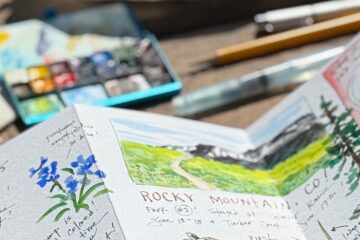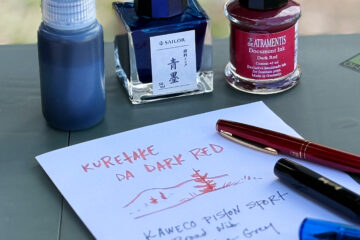I’ve had Cobalt Teal Blue on my palette for years — it’s one of my favorites. I’ve found that not many people know about this glorious color and all the magic mixes you can make with it, so I decided to write this Ode to Cobalt Teal Blue.
- This is pigment number PG50
- Daniel Smith (DS) calls it Cobalt Teal Blue (15 ml)
- Winsor and Newton (WN) calls it Cobalt Turquoise Light (5 ml or 14 ml)
(Note: the above links are my Amazon affiliate links and if you make a purchase using the link I’ll receive a small commission at no charge to you — thank you! I always try to support local businesses when possible, of course!)
It’s given “Top 40” pigment status at handprint.com:
Cobalt titanate green PG50 is a very lightfast, semiopaque, moderately staining, mid valued, moderately intense green blue to moderately dark, moderately dull blue green or green pigment, available from 10 pigment manufacturers worldwide. Like other cobalt pigments, all manufacturer tests (as well as my own) show these pigments have “excellent” (I) lightfastness, though they are still unrated by the ASTM. In watercolors the PG50 pigments undergo a very small drying shift, holding their lightness and dropping in saturation by 10% or less.
— Bruce MacEvoy, handprint.com
I find that the Daniel Smith version has more granulation and is a bit weaker in mixes, while the Winsor and Newton version seems to have smaller pigment particles and rewets better in my palette. Either one is a wonderful addition to your palette.
Here are some of my uses for PG50:
- I use this on it’s own for the color of the sky close to the horizon — I find it’s a much better match for desert skies than the more commonly used cerulean blue.
- Mixed with DS Venetian red it makes the perfect opaque desert green. Its opacity makes it where I can paint over backgrounds and gives agaves, cacti, yuccas and succulents a solid feeling instead of a transparent leafy green.
- Mixed with quin rose it makes lovely granulating purples.
- With quin gold it turns a bright spring green.
- Mixed with raw sienna makes a paler desert green.
Pigment Particles and Handling
Here’s a closer look at some of Cobalt Turquoise light mixes on Canson Montval student grade paper:
I’ve found that the paper that you use can really make a difference in how the heavier particles settle. You get a much more uniform swatch on Arches cold press paper.
Alternative: DaVinci Cobalt Turquoise (PB36)
A close alternative to PG50 is DaVinci’s version of PB36, called Cobalt Turquoise. As you can see, the mixes are pretty similar.
PB36 is also a “top 40” pigment at handprint.com:
The many shades of cobalt tin oxide (PB35) or cobalt chromium oxide (PB36), named cerulean blue, cerulean blue GS, cobalt turquoise or cobalt green deep, are very lightfast, semiopaque, moderately staining, granulating, dark valued, moderately dull to moderately intense blue to green blue pigments. PB36 is available from 9 pigment manufacturers worldwide (primarily as a colorant for ceramics, cement and industrial paints). The ASTM (1999) rates the lightfastness of these pigments in watercolors as “excellent” (I); manufacturer and my own tests agree. In watercolors, PB35 and PB36 show a very small (cerulean hues) to moderate (turquoise hues) drying shift, not lightening at all but losing from 5% to 20% in saturation.
The DaVinci version is so much greener than the WN or DS versions of cerulean blue!
I had the DaVinci version on my palette for many years as it is less expensive, but I had bad experiences with it in the heat: it would get kind of like maple syrup and dry weird in the pan!
Let me know if you use Cobalt Turquoise and what your favorite mixes are — I’d love to hear!






7 Comments
Tami · March 25, 2022 at 7:15 pm
Oh wow what an awesome post! I picked up both DS – CTB and W&N CTL and love them both. They behave so differently when painting. I have never seen the mixes you achieved here, I love your mixes! Awesome work!!
Lisa Spangler · March 25, 2022 at 8:45 pm
Thank you so much! They’re both really great paints!
Mareli · March 27, 2022 at 3:13 am
My first introduction to this pigment was Schmincke’s Cobalt Turquoise, which looks similar to you WN swatches. I absolutely love this pigment and I always stock up on it when I manage to find a tube.
I sometimes paint cartoon portraits of friends and adding a pop of this colour always brightens a portraits background.
Lisa Spangler · March 27, 2022 at 2:16 pm
I haven’t tried Schmincke’s version but it does look similar! I think it would be great in background!
Bob Cochran · April 3, 2022 at 6:24 pm
I will have to get these paints.
Bob Cochran · April 6, 2022 at 7:07 pm
Hi Lisa, I purchased the Daniel Smith product. This is my first Daniel Smith purchase, as I’m very much a beginner. All my other paints are by M. Graham. I did also get the Winsor & Newton Designers Gouache. When you paint mixes on paper, what is your method for that? Do you mix the paints first on the palette mixing area with the brush, and then apply the color to the paper? I can probably answer that one by studying the “Explore the Desert” video more carefully. But what temperature is the mixing area? I assume it is very warm given your climate? What temperature is the water that you use? Is the water temperature important? What about the brush hairs? I assume they are the same temperature as the surrounding air. Is that important?
Lisa Spangler · April 6, 2022 at 7:24 pm
Hi Bob! Here are some answers to your questions:
Regarding temperature, the water has to be above freezing (some artists add vodka or gin to their paint water to keep it from freezing). As far as heat goes, I’ve painted in 100 degree weather and some paints get kind of goopy — there’s nothing to be done about that tho. Just try to keep your palette out of direct sun and don’t leave it baking in a hot vehicle and you should be good.
As far as mixing goes there are two methods here. The first one is to mix your paints on the palette by grabbing some of one color and making a puddle with it in a mixing area, then grabbing the second color with your brush and adding it to the puddle with the first color. Mix them around with you brush and then paint on paper. Some people rinse their brush out before grabbing the second color but I usually don’t. :) I try to mix a big enough puddle to cover the area to be painted.
The second method is to let the paint mix on the paper. For this one, paint some of the first color on the paper, then load your brush with the second color and paint it directly into the first wash while it is still wet. Use your brush to work the colors together but don’t overdo it.
There are advantages to both methods — the first method gives you a uniform color while the second one can make some really neat effects! Hope that helps!